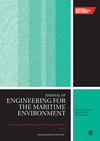Smart carrot chasing guidance law for path following of unmanned surface vehicles
IF 1.5
4区 工程技术
Q3 ENGINEERING, MARINE
Proceedings of the Institution of Mechanical Engineers, Part M: Journal of Engineering for the Maritime Environment
Pub Date : 2023-10-10
DOI:10.1177/14750902231200684
引用次数: 0
Abstract
Carrot chasing guidance law is one of the most widely used path following algorithms due to its simplicity and ease of implementation; however, it has a fixed parameter which leads to large cross-tracking errors during different navigational conditions. This study proposes an innovative approach to carrot chasing algorithm to minimize cross-tracking errors. Pattern search optimization technique is integrated with carrot chasing guidance law to determine unique virtual target points obtained by flexible parameters instead of a fixed parameter. Proposed smart carrot chasing guidance law (SCCGL) provides stable and accurate path following even for different navigational conditions of unmanned surface vehicle (USV). To the best of our knowledge, we are the first to apply pattern search optimization technique to carrot chasing guidance law while USV is performing multi-tasks of predefined paths. This novelty significantly reduces both cross tracking errors and computational costs. Firstly, SCCGL is tested and compared with traditional carrot chasing algorithm in the numerical simulator for several navigational conditions such as different lists of waypoints, different initial locations, and different maximum turning rates of USV. SCCGL automatically determines optimal parameters to make stable and accurate navigation. SCCGL significantly reduces cross tracking errors compared to classical carrot chasing algorithm. This is the first contribution of this paper. Secondly, genetic algorithm optimization method has been implemented to carrot chasing guidance law instead of pattern search optimization technique. Genetic algorithm causes the total simulation time to be quite long. The proposed SCCGL (pattern search integrated carrot chasing guidance law) gives optimum results 20 times faster than the genetic algorithm. This is the second and main contribution of developed SCCGL method. It is observed that SCCGL provides best navigation with minimum cross-tracking errors and minimum computational cost compared to the classical carrot chasing algorithm and other optimization technique.无人水面车辆路径跟踪的智能胡萝卜追逐制导律
胡萝卜追逐制导法是一种应用最广泛的路径跟踪算法,具有简单易行的特点;但由于其参数固定,在不同的导航条件下会产生较大的交叉跟踪误差。本研究提出一种创新的胡萝卜追踪算法,以减少交叉追踪误差。将模式搜索优化技术与胡萝卜追逐制导律相结合,以确定由柔性参数而不是固定参数获得的唯一虚拟目标点。提出的智能胡萝卜追逐制导律(SCCGL)能够在不同的导航条件下为无人水面飞行器提供稳定、准确的路径跟踪。据我们所知,我们首次将模式搜索优化技术应用于USV执行预定义路径的多任务时的追胡萝卜制导律。这种新颖性大大降低了交叉跟踪误差和计算成本。首先,在数值模拟器上对SCCGL算法与传统追胡萝卜算法在不同航路点列表、不同初始位置、不同USV最大转弯速率等导航条件下进行了测试和比较。SCCGL自动确定最佳参数,实现稳定、准确的导航。与经典的胡萝卜追踪算法相比,SCCGL显著降低了交叉跟踪误差。这是本文的第一个贡献。其次,将遗传算法优化方法应用于胡萝卜追逐制导律,取代模式搜索优化技术。遗传算法导致总仿真时间较长。所提出的SCCGL(模式搜索集成胡萝卜追逐制导律)比遗传算法的优化速度快20倍。这是开发的SCCGL方法的第二个也是主要贡献。与经典的胡萝卜追逐算法和其他优化技术相比,SCCGL能够以最小的交叉跟踪误差和最小的计算成本提供最佳导航。
本文章由计算机程序翻译,如有差异,请以英文原文为准。
求助全文
约1分钟内获得全文
求助全文
来源期刊

CiteScore
3.90
自引率
11.10%
发文量
77
审稿时长
>12 weeks
期刊介绍:
The Journal of Engineering for the Maritime Environment is concerned with the design, production and operation of engineering artefacts for the maritime environment. The journal straddles the traditional boundaries of naval architecture, marine engineering, offshore/ocean engineering, coastal engineering and port engineering.
 求助内容:
求助内容: 应助结果提醒方式:
应助结果提醒方式:


